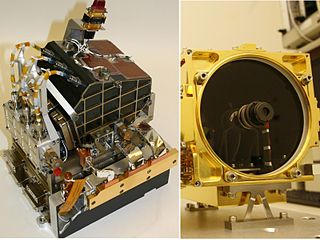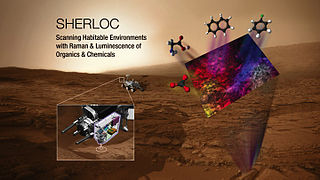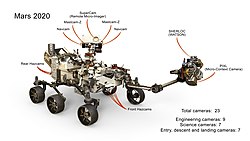
Raman spectroscopy is a spectroscopic technique typically used to determine vibrational modes of molecules, although rotational and other low-frequency modes of systems may also be observed. Raman spectroscopy is commonly used in chemistry to provide a structural fingerprint by which molecules can be identified.

Absorption spectroscopy is spectroscopy that involves techniques that measure the absorption of electromagnetic radiation, as a function of frequency or wavelength, due to its interaction with a sample. The sample absorbs energy, i.e., photons, from the radiating field. The intensity of the absorption varies as a function of frequency, and this variation is the absorption spectrum. Absorption spectroscopy is performed across the electromagnetic spectrum.

A gamma-ray spectrometer (GRS) is an instrument for measuring the distribution of the intensity of gamma radiation versus the energy of each photon. The study and analysis of gamma-ray spectra for scientific and technical use is called gamma spectroscopy, and gamma-ray spectrometers are the instruments which observe and collect such data. Because the energy of each photon of EM radiation is proportional to its frequency, gamma rays have sufficient energy that they are typically observed by counting individual photons.

The Miniature Thermal Emission Spectrometer (Mini-TES) is an infrared spectrometer used for detecting the composition of a material from a distance. By making its measurements in the thermal infrared part of the electromagnetic spectrum, it has the ability to penetrate through the dust coatings common to the Martian surface which is usually problematic for remote sensing observations. There is one on each of the two Mars Exploration Rovers.
Chemical imaging is the analytical capability to create a visual image of components distribution from simultaneous measurement of spectra and spatial, time information. Hyperspectral imaging measures contiguous spectral bands, as opposed to multispectral imaging which measures spaced spectral bands.

Mawrth Vallis is a valley on Mars, located in the Oxia Palus quadrangle at 22.3°N, 343.5°E with an elevation approximately two kilometers below datum. Situated between the southern highlands and northern lowlands, the valley is a channel formed by massive flooding which occurred in Mars’ ancient past. It is an ancient water outflow channel with light-colored clay-rich rocks.

Fourier-transform infrared spectroscopy (FTIR) is a technique used to obtain an infrared spectrum of absorption or emission of a solid, liquid, or gas. An FTIR spectrometer simultaneously collects high-resolution spectral data over a wide spectral range. This confers a significant advantage over a dispersive spectrometer, which measures intensity over a narrow range of wavelengths at a time.
This is a list of infrared topics.
Rosalind Franklin, previously known as the ExoMars rover, is a planned robotic Mars rover, part of the international ExoMars programme led by the European Space Agency and the Russian Roscosmos State Corporation. The mission was scheduled to launch in July 2020, but was postponed to 2022. The Russian invasion of Ukraine has caused an indefinite delay of the programme, as the member states of the ESA voted to suspend the joint mission with Russia; in July 2022, ESA terminated its cooperation on the project with Russia. As of May 2022, the launch of the rover is not expected to occur before 2028 due to the need for a new non-Russian landing platform.

Sample Analysis at Mars (SAM) is a suite of instruments on the Mars Science Laboratory Curiosity rover. The SAM instrument suite will analyze organics and gases from both atmospheric and solid samples. It was developed by the NASA Goddard Space Flight Center, the Laboratoire des Atmosphères Milieux Observations Spatiales (LATMOS) associated to the Laboratoire Inter-Universitaire des Systèmes Atmosphériques (LISA), and Honeybee Robotics, along with many additional external partners.

Curiosity is a car-sized Mars rover exploring Gale crater and Mount Sharp on Mars as part of NASA's Mars Science Laboratory (MSL) mission. Curiosity was launched from Cape Canaveral (CCAFS) on November 26, 2011, at 15:02:00 UTC and landed on Aeolis Palus inside Gale crater on Mars on August 6, 2012, 05:17:57 UTC. The Bradbury Landing site was less than 2.4 km (1.5 mi) from the center of the rover's touchdown target after a 560 million km (350 million mi) journey.

N165 is a rock on the surface of Aeolis Palus in Gale Crater on the planet Mars near the landing site of the Curiosity rover. The "approximate" site coordinates are: 4.59°S 137.44°E. On August 19, 2012, the rock was the first target of the rover's laser instrument, ChemCam, which can analyze targets at a distance using a laser and spectrometer. A Twitter feed for the rock was created, featuring an anthropomorphized account of its experiences. Its posts include a humor themed mix of social interaction and Mars content such as "Did you know I was born in a volcano? Basalts like me come from lava. That's why we call it Olympus Mom".

Chemistry and Camera complex (ChemCam) is a suite of remote sensing instruments on Mars for the Curiosity rover. As the name implies, ChemCam is actually two different instruments combined as one: a laser-induced breakdown spectroscopy (LIBS) and a Remote Micro Imager (RMI) telescope. The purpose of the LIBS instrument is to provide elemental compositions of rock and soil, while the RMI will give ChemCam scientists high-resolution images of the sampling areas of the rocks and soil that LIBS targets. The LIBS instrument can target a rock or soil sample from up to 7 m (23 ft) away, vaporizing a small amount of it with about 30 5-nanosecond pulses from a 1067 nm infrared laser and then observing the spectrum of the light emitted by the vaporized rock.

Scanning Habitable Environments with Raman and Luminescence for Organics and Chemicals (SHERLOC) is an ultraviolet Raman spectrometer that uses fine-scale imaging and an ultraviolet (UV) laser to determine fine-scale mineralogy, and detect organic compounds designed for the Perseverance rover as part of the Mars 2020 mission. It was constructed at the Jet Propulsion Laboratory with major subsystems being delivered from Malin Space Science Systems and Los Alamos National Laboratory. The current Principal Investigator is Kevin Hand, and the Deputy Principal Investigator is Kyle Uckert.
Contribution to ARIEL Spectroscopy of Exoplanets (CASE) is a detector subsystem contribution to an infrared spectrometer instrument for the planned European ARIEL space telescope. It is being developed by NASA as a contribution to the European Space Agency (ESA) project to add scientific capabilities to the space telescope to observe the chemical composition of the atmospheres of exoplanets, as well exoplanetary metallicities. The ARIEL spacecraft with CASE on board is planned to launch in 2029.
Raman Laser Spectrometer (RLS) is a miniature Raman spectrometer that is part of the science payload on board the European Space Agency'sRosalind Franklin rover, tasked to search for biosignatures and biomarkers on Mars. The rover is planned to be launched not earlier than 2028 and land on Mars in 2029.
Infrared Spectrometer for ExoMars (ISEM) is an infrared spectrometer for remote sensing that is part of the science payload on board the European Space Agency'sRosalind Franklin rover, tasked to search for biosignatures and biomarkers on Mars. The rover is planned to be launched not earlier than 2028 and land on Mars in 2029.

Michael Morris is an American biochemist, oceanographer and businessman, who has designed, developed and marketed new applications of optical sensing technology and spectroscopy. He has founded several companies including pHish Doctor, Ocean Optics Inc. (OOI), and SpectrEcology.

Vandana "Vandi" Verma is a space roboticist and chief engineer at NASA's Jet Propulsion Laboratory, known for driving the Mars rovers, notably Curiosity and Perseverance, using software including PLEXIL programming technology that she co-wrote and developed.

Perseverance, nicknamed Percy, is a car-sized Mars rover designed to explore the Jezero crater on Mars as part of NASA's Mars 2020 mission. It was manufactured by the Jet Propulsion Laboratory and launched on July 30, 2020, at 11:50 UTC. Confirmation that the rover successfully landed on Mars was received on February 18, 2021, at 20:55 UTC. As of 6 April 2024, Perseverance has been active on Mars for 1113 sols since its landing. Following the rover's arrival, NASA named the landing site Octavia E. Butler Landing.





















